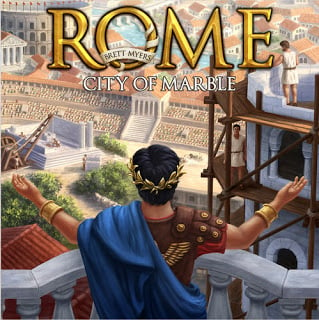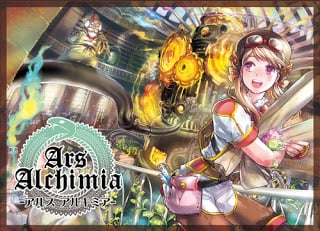One of the most overused adages of all time goes, "Rome wasn't built in a day." While that may be sage advice for those impatient people, some of us might indeed want to build the Eternal City in a day, or better yet an hour. Luckily, R & R Games has provided us with just such an experience in their tile-laying game Rome: City of Marble, a game for 2 to 4 players, age 12+. It takes between 45 and 75 minutes to play and retails for $40. In this game, you and your opponents are prominent families in the time of Augustus. You are all trying to help build Rome into its glory and claim the title of Architect of Rome!

Rome: City of Marble is a tile-laying, area control game that I would classify as deceptively simple. You can complete two actions a turn (not counting bonus actions) and the bulk of those actions, you are drawing tiles or playing tiles. However, you have to be careful with the tiles you play and when you play them, because you might create a construction site where you don't have the majority, thus resulting in points for your opponent--not you. In the simplest of comparisons, it reminds me of the pen and paper game Dots and Boxes, where you are trying to draw lines and complete boxes without setting your opponent up to complete boxes. However, if I left the comparison at that, it would not do the game justice.
With most tile-laying games, you have a tile and you have a very finite number of places you can legally place the piece and only one of those places is remotely good anyhow. This game is not like that at all. It provides lots of different places to place your tile, all equally good and equally tough in if you should place it there or wait. In a two-player game, which I played more than other player counts, there is a lot of blocking that can occur, since you can tie for majority and no one gets points. That can happen more often than not and result in a lot of feelings, of "If I can't have it, neither can you." This made for a tense and sometimes frustrating game experience, but those hurt feelings aren't there as much in a higher player count. Overall, I enjoyed the puzzle nature of the game and would recommend it.
[tweet "Two games for #history and #science buffs, reviewed by @StuartsStudy #familygamenight"]

One of my favorite Japanese manga/anime was Fullmetal Alchemist. The story was solid and the idea of alchemy has always been an interesting to me, even if I don't put any merit in it whatsoever. Recently, Tasty Minstrel Games released a game called Ars Alchimia, a game for 3 to 4 players, ages 10+. It takes approximately 100 minutes to play and retails for $40. In this game, you and your fellow overseers work at an alchemy factory. Your job is to take orders, gather resources, and transmute them. Sounds simple, but efficiency is key!
When playing through this game, you realize that it has a lot of elements of a traditional worker placement. You deploy workers to gather resources. You use those resources to make items, which are worth points. However, there are slight differences in this game than more traditional worker-placement games. The first difference is worker escalation, or going to the same place someone else did, but using more workers than someone else used. This means that no space is entirely blocked off, and it also means that you can mess with someone by going to a spot before they can and sending a lot of workers. The second difference is a die. At some locations, you can roll a die. If you get the number on the die required, then you gain an additional resource/benefit. This can be mitigated by the amount of workers you send to a place, but it still adds a random element to the game, which can be fun or frustrating depending on your luck of the die.
The game itself is tiny in nature in terms of box, components, and footprint, which is nice for someone with a lot of games and not a lot of shelf space. Since the game saw its origins in Japan, this makes absolute sense. The artwork is also a Japanese anime/manga, which I like. The components are basic in nature (standard pawns and cubes), which is a drawback compared to some of the more recent games, but the colors are at least unique, bright and vibrant, making them pop on a somewhat busy board! I also like that you can have up to 20 workers in the game. Now, granted, you won't be taking 20 actions per round, but you feel a lot less limited in what you can do when you see that army of pawns! The last element I really like about the game is the shifting places to visit. This creates a nice in game dynamic and need to be on your toes at all times. It also adds a great replay value, because even though you will see the same cards in different games, it won't always be in the same order.
It's no surprise if you have read any of my other reviews, but I love worker placement games. This was a very fun game and had unique twist on worker placement, which you must have to differentiate yourself from the myriad of other worker placement games. If you are looking for a compact worker placement game that packs a punch, I highly recommend Ars Alchimia.
Copyright 2017 Stuart Dunn
About the Author

Stuart Dunn
Stuart Dunn was born and raised in Mobile, AL and received a Bachelor of Arts in Psychology and a Master of Business Administration from the University of South Alabama. Stuart reviews all things Catholic including adult books, children’s books, Bible Study series, Catholic Courses, CDs, and DVDs in addition to board games at his blog Stuart’s Study at StuartsStudy.blogspot.com.



.png?width=1806&height=731&name=CatholicMom_hcfm_logo1_pos_871c_2728c%20(002).png)
Comments